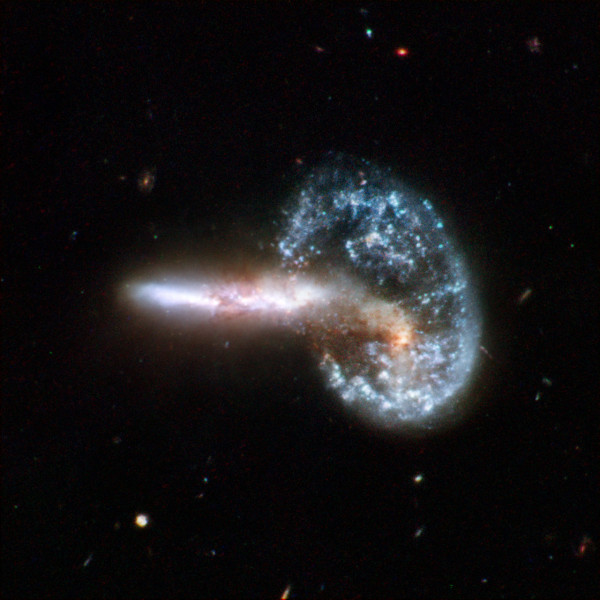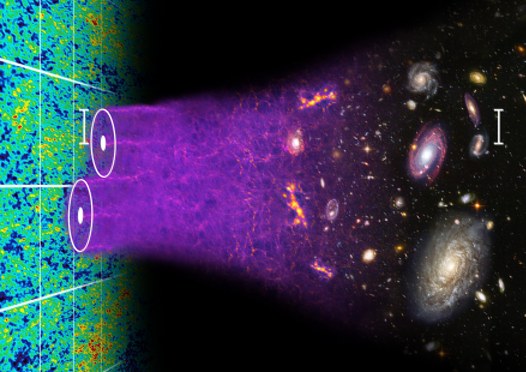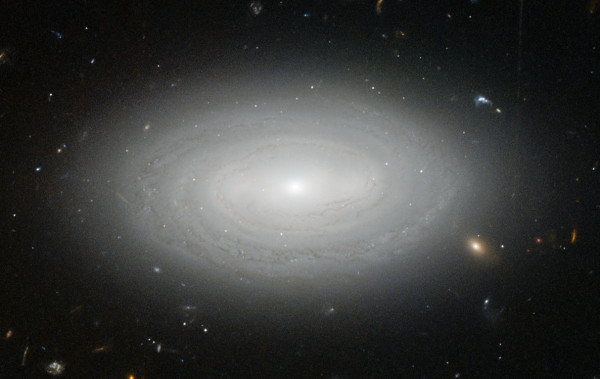"The big secret in life is that there is no big secret. Whatever your goal, you can get there if you're willing to work." -Oprah
And 2016 is here! So begins another great year for Starts With A Bang, and I'm so pleased you're still here as well. Yes, I know there are some frustrations with Forbes' ad policies, but at least they appear to have stopped the "Welcome to Forbes" interstitial, which is something! (And if you missed it, Medium now knows that I'm over there, too.) In any case, here's what the last week has seen:
- How big was the Universe when it was first born? (for Ask Ethan),
- Overlapping, but not colliding galaxies (for Mostly Mute Monday),
- A spectacular auroral show to ring in the new year,
- Why are we made of matter and not antimatter?, and
- The ten greatest steps of the last ten decades.
Plus, of course, our latest podcast: on baryogenesis!
Image credit: E. Siegel, of the size of the Universe (in light years) vs. the age of the Universe (in years).
From PJ on the size of the Universe: "Something else to think about; we are not necessarily at the centre of this expansion, so the extent of the universe is much greater than that which we can see for the moment. What we do not see is the changes having taken place up to the present moment."
It's pretty important to remember, when we talk about "the Universe," that sometimes we mean the observable Universe, and sometimes we mean the whole, entire whatever-there-is, including whatever may be unobservable. So I feel that in this article, it's pretty clear that we were talking about the observable Universe, rather than the whole whatever-there-is. But if we want to ask about that, there are a few important things we can say, mostly from our view of the CMB and from Baryon Acoustic Oscillations on the largest scales.
The fact that we see no recurring structures, or structures that appear at one location in the Universe and then again in a different location, we can infer that if the Universe is a topologically closed system, it's greater in extent than the visible part of it. If we then assume that the spatial curvature we observe is representative of the curvature of the Universe, our best constraints tell us that if it is closed, then the entire Universe is at least a factor of 400 times larger in radius than what we observe, or 64,000,000 times (400^3) larger in volume. Inflation predicts, of course, that its likely many, many times larger than even that, but that's the limit of what we can observe. (That limit, by the way, was announced at last year's AAS by the SDSS-III/BOSS collaboration. Perhaps this year will reveal an even more stringent one!)
From Omega Centauri on the loneliest galaxy in the Universe: "I think if one could count the number of sunlike stars in void galaxies and the number of stars in/near clusters, the ratio would be very small, so the odds for any randomly selected civilization, is that they won’t have this problem."
Well, that's true for any randomly selected civilization, but what are the odds that a civilization around a star comes to be and reach the level where it can ask those such questions? It's pretty low, for certain, but we know it happened at least once in our galaxy, and this one is many times larger. (At least five times as many stars, by most estimates.) So the issue isn't whether a random civilization would have this problem, but whether there's a civilization in this galaxy that has that problem. And the answer -- as it is to all heretofore unknown questions -- is maybe.
Image credit: Wikimedia Commons user Lunch, of a 2-D projection of a Calabi-Yau manifold, one popular method of compactifying the extra, unwanted dimensions of String Theory.
From Rafael Bernal on string theory and whether it's a scientific theory: "One of the clearest articles I’ve seen explaining how a scientific theory is different from a mathematical one. I’ve always argued that the string theorists are mathematical mavericks, but all the math in the world makes no science!
We could ask, Where is the beef? (In this case the experimental / empirical proof?"
This is something that I stand behind that has clearly gotten a lot of people worked up. There's not a problem with working on something that hasn't yet given a concrete prediction that one could look to, either verifying or running counter to the theory's expectations. But like many ideas, the connection to a physical observable is missing, and that's a very tough sell to me as a scientific theory. Mathematical physicists work all the time on things which very clearly have no connection to reality: E(9) groups and above, extensions of the quaternions and octonions to higher superalgebras, even revived versions of the old Sakata model of hadrons. (To most of you, I recognize these words are meaningless; don't worry about it.) That sort of thing isn't interesting to me from a physics point-of-view, and when I'm feeling particularly snarky, I have a special word for it: mathsturbation.
The (non-snarky) point is, you need a connection to something you can measure! It can be measured in principle rather than (right now) in practice, but it needs to have a connection to an observable quantity. Otherwise, what you're doing might be interesting and might someday lead to a scientific prediction, but it's hard to justify calling something a scientific theory that can't be tested. In any case, the distinction between a mathematical and a scientific theory was what I was going for, and I'm glad at least one person picked up on that.
 Image credit: Cabrera B. (1982). First Results from a Superconductive Detector for Moving Magnetic Monopoles, Physical Review Letters, 48 (20) 1378–1381.
Image credit: Cabrera B. (1982). First Results from a Superconductive Detector for Moving Magnetic Monopoles, Physical Review Letters, 48 (20) 1378–1381.
From Alan L. on a possible monopole prank: "how could a prank of this kind be carried out so as to create the effect of having a charge of almost 8 magnetons be sent, presumably almost instantaneously, to the computer linked to the detector SQUID?"
Very, very easily: by sending a digital signal to the computer/detector. For it to be a random fluctuation is much, much harder; fluctuations typically return to baseline quickly, and were never more than 2 magnetons in magnitude otherwise. Yet there were exactly eight turns of wire, and a signal of 8 magnetons were observed. What was it? If it was the only magnetic monopole in our (observable!) Universe, the world may never know.
 Image credit: Gemini South image of NGC 5426-27 (Arp 271) as imaged by the Gemini Multi-Object Spectrograph.
Image credit: Gemini South image of NGC 5426-27 (Arp 271) as imaged by the Gemini Multi-Object Spectrograph.
From See Noevo on antimatter beings: "Perhaps the first living things WERE made of antimatter, but eventually nature selected against them. But they left behind no fossils, or at least, none that we’re capable of seeing. You know, because of what they’re made of."
This is maybe the easiest kind of idea to deal with: the demonstrably incorrect idea. The problem with antimatter is that it annihilates with any normal matter it comes into contact with. If any antimatter ever existed on Earth, it was destroyed during Earth's formation in a matter of timescales much less than even one second. If any antimatter came to Earth since, it was destroyed in our atmosphere in short order. In order to have a living being come to Earth, it would have had to have come from beyond our own galaxy, in which case we would see an antimatter galaxy, which doesn't exist in our observable Universe.
In other words, this is a fun idea to entertain, but it can swiftly be shown to not describe our Universe. Which is good: antimatter living creatures wouldn't want to meet us any more than we'd want to meet them!
From Ella on urobilins (written back in 2009): "Wow! So much I didn’t know. It is sort of disgusting, I guess, but you have to learn! This is amazing!"
Seven years later, people still find this stuff, and find it amazing. That's some advice for you: index your pages on Google, everyone with a blog!
Speaking of necromancing old threads, here's one from Hugh Beaumont on Alan Shepard's golf shot on the Moon: "If you are going to hit a ball upward at a 45 degree angle it has be on a tee. This ball was dropped in the dust. The only way to get elevation is to hit “down” on it to produce backspin – the dimples on the golf ball interact with the air and this makes the ball rise. No air – no backspin – no altitude – no “miles and miles”. Complete baloney."
So... let's dissect it, because there are two big misunderstandings here. One is that a golf ball needs to be on a tee to hit it upwards at 45 degrees. Actually, a club with a tilted head is going to impart a force on the golf ball with a tilt to it. All golf clubs have tilted heads, and while the mechanics of your swing or the lie of the ball can affect exactly what angle the ball comes off at, there's no reason why it's impossible to hit a ball upwards at a 45 degree angle unless you're on a tee. The Moon might be akin to the ultimate sand trap, but Shepard made a drop rather than a "shot" and used a 6-iron, which seems fair.
 Image credit: © 2016 Rocky River Golf Club, screenshot from FlightScope, via http://www.rockyrivergolf.com/course/teaching-center/.
Image credit: © 2016 Rocky River Golf Club, screenshot from FlightScope, via http://www.rockyrivergolf.com/course/teaching-center/.
The second point is how a ball interacts with the air, which the Moon quite obviously doesn't have. Somehow, you (confusedly) think this is bad for the flight of the ball, rather than good, since the ball now doesn't have to contend with any form of air resistance! Sure, a golf ball does better than a perfect sphere, but how does that compare to either shape (since shape doesn't matter without air) on the Moon?
Thankfully, you don't need me; this problem has been solved!
 Image credit: The Atmospheric-Optics Laboratory, Dalhousie University, Halifax, Canada, via http://aolab.phys.dal.ca/~tomduck/classes/phyc2050/.
Image credit: The Atmospheric-Optics Laboratory, Dalhousie University, Halifax, Canada, via http://aolab.phys.dal.ca/~tomduck/classes/phyc2050/.
You'll want to hit your golf shot at a 45 degree angle, optimally, without air resistance, and follow mission control's advice to the best of your ability. On Apollo 14, Alan Shepard actually got some.
Mission control: You need to bend your knees a little more. Keep your head down.
Alan Shepard: I’m… wearing a space suit.
Mission control: Just trying to help.
It didn't help.
 Arp 148. Image credit: NASA, ESA, the Hubble Heritage (STScI/AURA)-ESA/Hubble Collaboration, and A. Evans (University of Virginia, Charlottesville/NRAO/Stony Brook University).
Arp 148. Image credit: NASA, ESA, the Hubble Heritage (STScI/AURA)-ESA/Hubble Collaboration, and A. Evans (University of Virginia, Charlottesville/NRAO/Stony Brook University).
And finally, from Gary S on the matter/antimatter controversy: "How do we know that there are NOT equal numbers of “normal” and anti-matter galaxies? Are there astronomical observations which could tell?"
Absolutely, Gary! You see, if there were antimatter galaxies out there, then there should be some interface between the matter and antimatter ones. Either there would be a discontinuity (like a domain wall) separating the two regions, there would be an interface where gamma rays of a specific frequency originated, or there would be a great 2D void where it's all already annihilated away.
And our Universe contains none of these things. The absence of them in all directions and in all locations tells us that if there are antimatter galaxies out there, they're far beyond the observable part of our Universe. Instead, every interacting pair we see shows evidence that they're all made of matter. Beautiful, beautiful matter.
 Arp 274, a trio of star-forming galaxies. Image credit: NASA, ESA, M. Livio and the Hubble Heritage Team (STScI/AURA).
Arp 274, a trio of star-forming galaxies. Image credit: NASA, ESA, M. Livio and the Hubble Heritage Team (STScI/AURA).
Thanks for joining me this week and for kicking off the year right. Can't wait to see what the rest of 2016 has in store!






@Ethan re Gary S's question about antimatter galaxies: See http://arxiv.org/abs/1512.08482 for a recent analysis of a slightly more complex "domain wall" analysis, where the authors consider a smooth (Gaussian) density interface between the hypothetical regions.
They first show that this model entirely escapes the best limits on "domain wall" type backgrounds (from COMPTEL, back in the day!). But what I liked is that they go further, and compute the apparent temperature effects from annihilation, and compare that with Planck data. They end up with a ~50 sigma discrepancy vs. data (chi^2 ~ 2400), which is a great exclusion.
My bad - missed the 'observable' in the second sentence of your opening para of the SWAB intro. :)
The next time someone tries to argue that NASA folks didn't have a sense of humor, think of this.
Ethan, I'll give another go at explaining my WAGing on the subject of supermassive black holes being formed after a galaxy has formed or being the cause of the formation of a galaxy being discoverable if we look at the location of the black hole in a galaxy. It was never very clear when it was discussed in two posts a while ago.
The idea is that if we look in the past, if we see more supermassive black holes offset from the CoM of the galaxy, that the supermassive black hole is liable to be caused after the galaxy has formed, but if they're consistently central, then it's liable that the galaxy formed around the SMBH.
That may not be the way it came across, though, hence the longer repost.
The thinking is that SMBH if formed after, then it can theoretically form anywhere there is sufficient density AND the random placement of events to build it up, and though this is more likely where the gas is densest, and that is more likely to also be where the densest star field is, and that is most likely the centre of mass of the galaxy, that doesn't have to be so: anywhere could form a large BH, and accumulation is hard when the object is under a light second across and the distance between objects light years.
Whereas if the formation of the galaxy is caused by the SMBH, that causation has to lead to forming AROUND the SMBH, hence central.
The wrinkle could be the chance of formation isn't enough different for us to locate unless we're just lucky to have one nearby with a larger offset.
Whether that is why we don't see the difference would require that someone work out the chances of a SMBH forming in a protogalaxy, and the density changes the SMBH causes in the protogalaxy if it is the "seed".
And if the SMBH formed notably outside the centre of the galaxy, the CoM could progress because of ratcheting up of the SMBH size is one way, whereas for a huge cluster of nearby stars, it isn't, it can go either way. Stars can be thrown out of the centre of the galaxy. Not so much out of a black hole. IF THAT HAPPENS, then it could lead to the current centre to be spread out around a wider and wider area as the CoM moves little by little toward the SMBH.
And therefore we'd see a large nucleus and we'd see a lower offset between CoM and SMBH.
To select a larger number of galaxies,we need to look further back, and that both reduces the ability to find any separation and may, as hypothesised above, be biased to making the change observable only to those least able to be separated out from detectors we currently have.
This is merely conjecture, there's a huge amount of simulation to even check if it's worth spending time looking, never mind the actual testing of the conjecture to make it a hypothesis with evidence for or against.
Re: antimatter; for the non-scientists its worth pointing out that there's anti-matter around, it's just not stable for very long. But positrons are produced in nature via pair production and in a small percent of K-40 decays. Humans also create positron emitting isotopes for use in medicine (the P in PET scan is for positron).
So, dear reader, the chances are very high that you've personally come into contact with anti-matter, and just not known it.